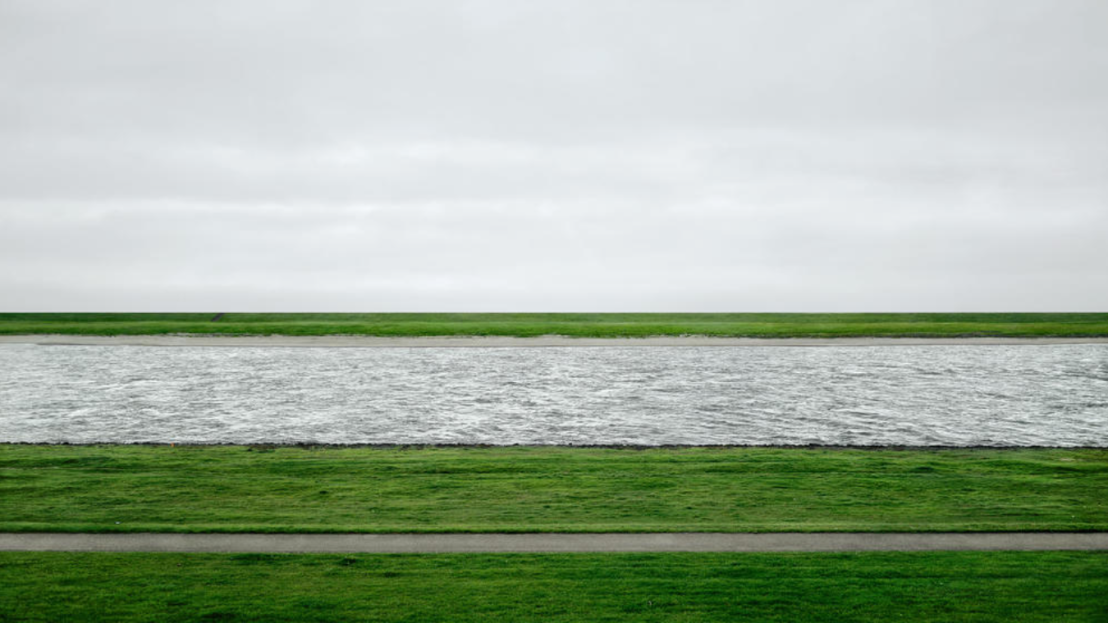All images copyright Andreas Gursky.
Today’s featured photographer is Düsseldorf School alumnus Andreas Gursky from Germany.
Like other photographers who will appear in this series, I’m not saying that I dislike all his work. Indeed, there are a great many images I do like, not least 99 Cent and similar frames that contain more elements than the brain can comprehend at one time. It’s fair to say that he has made this type of imagery so much his own domain that the typical response when seeing similar work by other photographers is often ‘That picture looks like a Gursky’. So credit where credit’s due.
This said, Gursky has had — and still has — real low points, at least in my opinion. Some may question whether my opinion counts for much when Gursky has succeeded in selling prints for millions of dollars. My response would be that even a mind-boggling sale price doesn’t validate an artwork as just that. ‘Rhein II’, which will be addressed below, is of course the standout example here.
The point is that despite extraordinary success, Gursky — like other photographers who will feature on this blog — fails to present consistently good work or dispose of his garbage, yet the audience plainly doesn’t care. This mystifies me. The images I’m borrowing here are all meaningless in my opinion, yet they include the most expensive photograph ever sold.
Am I missing something? You tell me, but until then I’m classifying Gursky as the Damien Hirst of photography, i.e. capable of the sublime and ridiculous in equal parts, either way for high prices.
Let us turn to the first image:

Entitled ‘Madrid’ (1988), it stems from the early part of his career, but this does nothing to change the fact that it is a monumentally banal image (for what it’s worth, my guess is that it was taken near Paseo del Prado, perhaps in Retiro Park). In my eyes, it is dreary to look at and devoid of any meaningful concept, so why should a viewer stand for more than three seconds in front of this image? Applying the Instagram test (i.e. to scroll or not to scroll, the lowest common denominator), would you even notice it? I certainly would not. Yet it is doubtless worth a fortune.

This second image, ‘Gasherd’ (or gas stove) dates from 1980, and is therefore very early Gursky (which some might call an ‘Ersky’). It’s not unreasonable to cut him some slack here since we all took questionable pictures when we were younger, and indeed the vast majority of us continue to do so now. What is annoying, however, is that this image continues to do the rounds, presumably solely by virtue of being an ‘Ersky’. This perhaps gives it economic value, but if I were he, I would want to see it disappear, because it’s a crap photo, no matter how much supporters might roll out the ‘art in banality’ credo. I do hope he remembered to turn off the gas.
This brings us to the final image, ‘Rhein II’ — the highlight or lowlight, depending on your perspective:

A print of ‘Rhein II’, for those who do not know, sold for over USD 4 million to an unknown buyer. While this may not be much compared to the tens of millions regularly forked out for paintings, it remains a vast sum for something reproducible with an email to your master printer, beyond the scope of most people’s dreams and capable of achieving great things if spent on something else. Is a print of this image really worth that much? The one thing we know for certain is that three people definitely think so: Gursky, his gallerist and the buyer.
What makes it even stranger is the fact that the image is a product of Photoshop. Gursky went to considerable pains to remove the background and replace it with sky, since the original image showed trees and structures on the far side of the river. So while it is called Rhein II, the end result is a Rhein that doesn’t actually exist. Hence, perhaps, the ‘II’, suggesting some kind of parallel universe. And hence, perhaps, the extraordinary price tag.
But all of this begs the key question: is it actually a good photo? In turn, this spawns an even trickier one, which is what is a good photo in the first place? I’ll chip away at the second question in subsequent blog posts, but if I’m to answer the first question in a single word it would be ‘no’.
Photography is so much about emotional response for a whole range of reasons, yet ‘Rhein II’ is so flat that it leaves me flat as well. I feel nothing looking at this, except a pang — ok, a roar — of jealousy at the sale price. What’s more, it has been manipulated to make you feel flat. Really, only a German, Lithuanian or a Scandinavian would do that to you.
Also perplexing is the fact that Gursky produced this work following a consistent run of seriously interesting images. Then, after years of ‘busy’ pictures, he hit us with something different: nothing. This is a nothing picture. And not a little pretentious in its nothingness. That said, it just goes to show how wrong King Lear was when he observed that ‘Nothing will come of nothing’. As it turns out, with a little marketing nous, nothing is worth four million dollars.
Conclusion? Gursky didn’t force the buyer to spend the money, so he can’t be blamed for that. But for me the photos discussed above are rubbish. Despite his manifest Photoshop skills, this leaves me no option but to crap on some of Gursky’s photos. Crap Factor 8/10.
